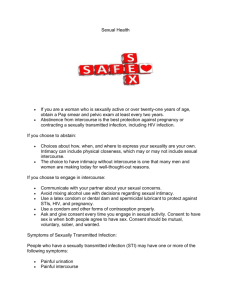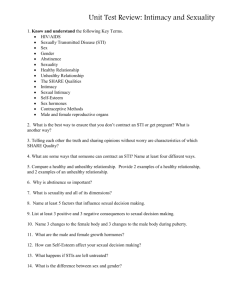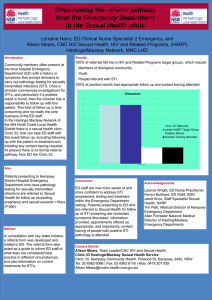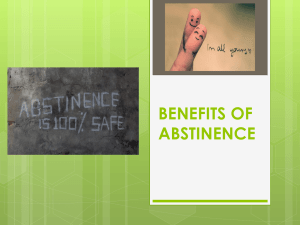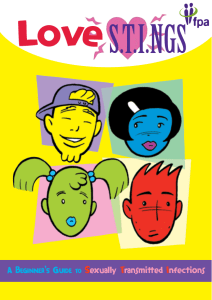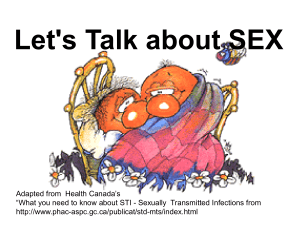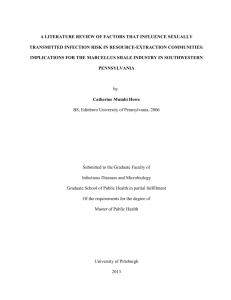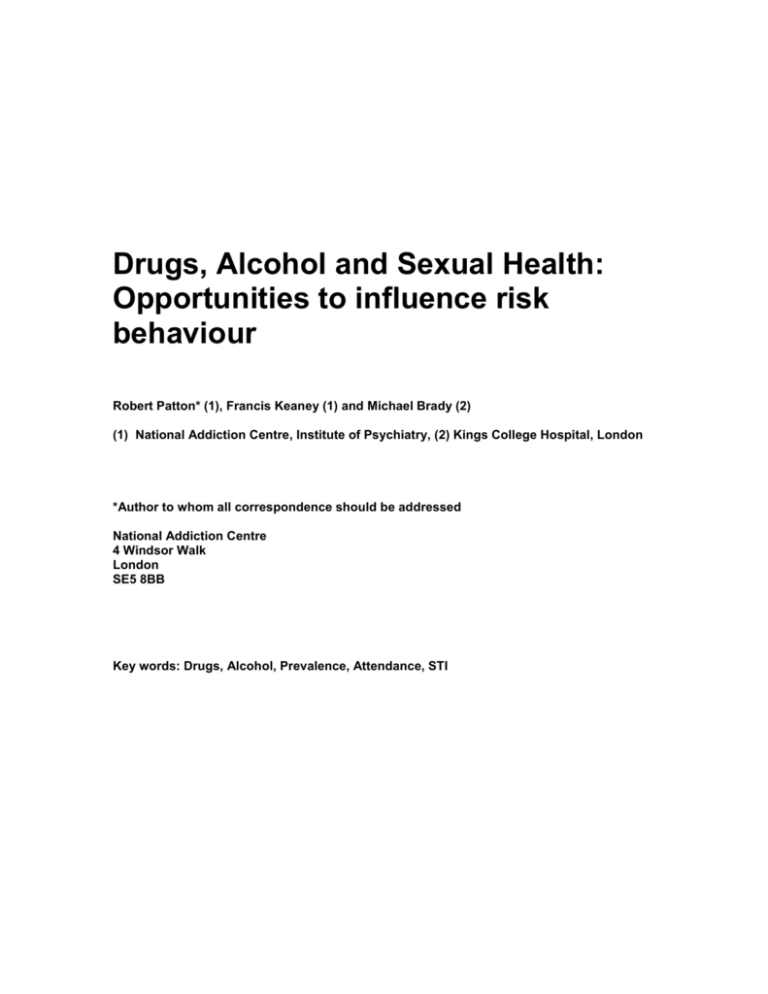
Drugs, Alcohol and Sexual Health:
Opportunities to influence risk
behaviour
Robert Patton* (1), Francis Keaney (1) and Michael Brady (2)
(1) National Addiction Centre, Institute of Psychiatry, (2) Kings College Hospital, London
*Author to whom all correspondence should be addressed
National Addiction Centre
4 Windsor Walk
London
SE5 8BB
Key words: Drugs, Alcohol, Prevalence, Attendance, STI
ABSTRACT
Alcohol and drug consumption can affect judgment and contribute towards an increased
likelihood of engaging in risky sexual behaviour. In a cross sectional survey of clients
attending STI services levels of drug and alcohol use were assessed. The rates of
hazardous alcohol consumption were similar to those found among patients attending
A&E departments. Approximately 15% of clients indicated possible dependence on
alcohol or other drugs, and these clients were likely to cite their substance use as related
to their attendance, and to accept the offer of help or advice. The use of brief screening
instruments as part of routine clinical practice is recommended.
INTRODUCTION
Research examining the prevalence of STIs and risk behaviours amongst a population of
drug users in treatment indicates a high level of unprotected sexual activity1 (22%).
Hwang et al2 found that 62% of drug users in treatment had serological markers for at
least one STI. Another study by Lally et al3 indicated that 23% of women in short-term
substance abuse treatment were infected. A review by Marx et al (1991)4 found
associations between drug use (particularly crack) and STIs.
High rates of hazardous drinking among clients were confirmed during a recent pilot
study based in the sexual health clinic at St Mary’s Hospital in inner-London5, however
no studies have been identified that explicitly examine the relationship between substance
use and levels of unprotected sexual activity or rates of STIs. The relationship between
drug taking and engagement in sexual activity (protected or unprotected) is important;
however the establishment of a causal relationship between the two remains unproven6.
METHOD
Over a six week period, a convenience sample of 700 clients attending the STI clinic of a
busy South London hospital were approached by a junior doctor. At the end of the
consultation, having obtained consent, the doctor administered the Brief Alcohol & Drug
Screen (a composite measure that includes the PAT7 and SDS8). Clients identified as
hazardous drug or alcohol users were offered a leaflet outlining how they could access
help with their substance use problem.
RESULTS
653 clients consented to participate in the study (93%). The majority of clients drank
alcohol (71%), with 28% identified as hazardous drinkers. 14.7% of clients were SDS
positive, indicating possible dependence. Overall 6.6% of the sample thought that their
attendance was related to their substance use. Binary logistic regression indicated that
hazardous drinking did not predict the acceptance an offer of help / advice (OR 0.5,
95%CI 0.25 – 0.90), however SDS+ status did (OR 17.24, 95%CI 9.01 – 32.26). SDS+
status also predicted patients who indicated that their attendance was related to their
substance use (OR 3.1, 95% CI 1.5 – 6.5).
Alcohol
(hazardous)
Cigarettes
Cannabis
Proportion
% (N)
SDS+
% (N)
Accepted help
% (N)
24.6 (45)
Attendance
related
% (N)
18.6 (34)
14.2 (26)
Would
attend
% (N)
84.6 (22)
28.0 (183)
13.8 (90)
5.3 (35)
35.6 (32)
54.3 (19)
4.4 (4)
8.6 (3)
38.9 (35)
40.0 (14)
91.4 (32)
100.0 (14)
DISCUSSION
Clinicians may be surprised at the low numbers of clients who related their attendance to
substance use; however this might be expected, given that in other settings, such as A&E
departments, rates are similar9. STI clinics are well placed both to identify substance use
and to offer help to those whose use is problematic. At present most STI services do not
routinely screen for alcohol or other drugs. The identification and appropriate referral of
those clients whose substance use may well be associated with their clinic attendance will
not only help to reduce clinic workload, but also enable STI services to deliver an
important public health message. This study indicates that using a brief screening
instrument for drug and alcohol as part of routine clinical work is a feasible proposition.
While clinicians may be reluctant to address issues of substance misuse in the clinic
setting, clients are certainly receptive to advice and onward referral, which we know will
help reduce their consumption and may reduce the likelihood of engaging in risk
behaviours.
Reference List
1. Liebschutz JM, Finley EP, Braslins PG, et al. Screening for sexually transmitted
infections in substance abuse treatment programs. Drug and Alcohol Dependence
2003;70:93-9.
2. Hwang LY, Ross MW, Zack C, Bull L, Rickman K, Holleman M. Prevalence of
sexually transmitted infextions and associated risk factors among populations of
drug abusers. Clinical Infectious Diseases 2000;31:920-6.
3. Lally MA, Alvarez S, ManNevin R, et al. Acceptability of sexually transmitted
infection screening among women in short-term substance abuse treatment.
Sexually Transmitted Diseases 2002;29:752-5.
4. Marx R, Aral SO, Rolfs RT, Sterk CE, Kahn JG. Crack, sex and STD. Sexually
Transmitted Infection 1991;18:92-101.
5. Crawford M, Lowe PC, Greene L, Brookings C. The prevalence of excessive
alcohol consumption and the acceptability of brief advice in a sexual health clinic:
cross sectional survey. Sexually Transmitted Infection 2004;80:416-7.
6. Rashad I,.Kaestner R. Teenage sex, drugs and alcohol use: problems identifying the
cause of risky behaviours. Journal of Health Economics 2004;23:493-503.
7. Patton R, Hilton C, Crawford MJ, Touquet R. The Paddington Alcohol Test: A
Short Report. Alcohol & Alcoholism 2004;39:266-8.
8. Gossop M, Darke S, Griffiths P, Hando J, Powis B, Hall W et al. The Severity of
Dependence Scale (SDS): psychometric properties of the SDS in English and
Australian samples of heroin, cocaine and amphetamine users. Addiction
1995;90:607-14.
9. Crawford MJ, Patton R, Touquet R, Drummond DC, Byford S, Barrett B et al.
Screening and referral for brief intervention of alcohol misusing patients in an
Accident and Emergency Department: A pragmatic randomised controlled trial. The
Lancet 2004;364:1334-9.



